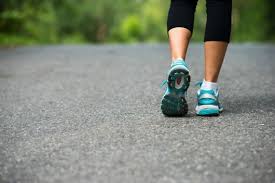 Exercise is an essential part of a healthy lifestyle no matter what your age, weight, health goals, or dosha type may be. Ideally, your routine should include a minimum of 30 minutes of “intentional movement” each and every day. However, just as your diet can either create balance or wreak havoc on your system, your exercise regimen can have the same effects. Therefore it is essential to know what your body-type is (Vata, Pitta, or Kapha), as well as any imbalance in your system to discover the best exercises for you and your current needs. This will help you choose the most appropriate exercise practices that will nourish and heal your body and mind, rather than create further imbalance.
Exercise is an essential part of a healthy lifestyle no matter what your age, weight, health goals, or dosha type may be. Ideally, your routine should include a minimum of 30 minutes of “intentional movement” each and every day. However, just as your diet can either create balance or wreak havoc on your system, your exercise regimen can have the same effects. Therefore it is essential to know what your body-type is (Vata, Pitta, or Kapha), as well as any imbalance in your system to discover the best exercises for you and your current needs. This will help you choose the most appropriate exercise practices that will nourish and heal your body and mind, rather than create further imbalance.
According to Ayurveda, the best exercise for just about any individual is good ol’ fashion walking. This can be a gentle walk for the Vata types or a brisk, fast-paced walk for Kapha; but overall walking is considered “tridoshic” and is beneficial for everybody, no matter what their constitution or their current imbalance is. Walking is fairly gentle on the joints and is beneficial for both your physical and mental health, especially when done outdoors. It is important to take time out each day for a walk, rather than consider “walking to work” or “walking at work” as exercise. The reason behind this is that “intentional movement” does not occur when we are racing to work or as we go about our busy day. Part of the healing comes not only from the act itself but from taking special, focused time to do it, in which you can allow the space to enjoy the fresh air and environment around you.
Although walking is great, it may be nice to get a variety going for your weekly exercise routine to keep you engaged, as well as to utilize different muscles in your body (including your heart!). You will have to gauge your current state of health and level of strength to ultimately decide which exercise is best for you, however, the list below will give you an idea of some basic exercises to choose from. By exercising for your dosha type (or current doshic imbalance), you will be achieving your physical exercise needs while also creating balance in your body and mind.
No matter what your dosha type or your health goals are, you will want to get at least 30 minutes of exercise each day to establish optimal health and well-being. If you currently do not have any exercise routine, it will likely be best to build up your weekly routine over time (slow and steady win the race!). This means that instead of jumping from 0 to 60, you will want to slowly incorporate a consistent exercise schedule by beginning with a goal of 3 days a week. After a couple of weeks of success with your initial goal, then you can increase the amount to 5 sessions a week; and then in time increase further until you reach your ultimate goal of 30 minutes of exercise, 7 days a week. Also, keep in mind that the lists below are non-exhaustive. You are welcome to play around with other types of exercise that are not listed, assuming you do so with awareness to see which exercise types leave you feeling energized (long-term) and which create depletion, exhaustion, anxiety, sleep issues, or the like.
A Quick Look into the Ancient Texts
Not surprisingly, the great ancient texts of Ayurveda speak about the proper and improper ways to perform the exercise. Exercise is known as vyayama in Sanskrit. Here are a few translations coming from the Ashtanga Hrdayam (Ch 2, Verse 10 to 14):
“Lightness (of the body), ability to do (hard) work, optimal digestion, reduction of fat, stable and distinct physique, come from vyayama (exercise).”
“Persons who are strong and who indulge in fatty foods, and are in cold and spring seasons (Kapha-predominant seasons), should exercise to half of their capacity only (meaning to just the point that perspiration begins and a slight dryness of the mouth occurs); while others (and during other seasons) should exercise mildly.”
“After exercising all parts of the body should be massaged comfortably (abhyanga).”
“Thirst, emaciation, severe dyspnoea (shortness of breath), bleeding diseases (bloody nose, bleeding hemorrhoids, etc), exhaustion, feelings of debility, cough, fever, and vomiting are all caused by an excess of exercise.”
“Those who indulge daily in too much physical exercise, keeping awake at night, walking long distances, sexual intercourse, too much laughing, too much speaking, and other strenuous activities perish, just as a lion, after vanquishing an elephant (apparently a lion dies soon after killing an elephant due to the strain and exhaustion that comes about).”
From these concise verses, you can clearly see that even thousands of years ago, the great Ayurvedic physicians acknowledge the benefits of proper exercise (for your needs) and the ill effects of inappropriate exercise choices. Let us now move on to a more modern view of how to use the ancient wisdom of Ayurveda and the doshic theory in our daily lives.
Take our “Discover your Dosha” Quiz!
Best Exercises for Vata Dosha
Vata dosha is made up of the kinetic elements of Air and Space, and therefore the best exercises will be slower-paced and more focused to balance out these elements. Vata types tend to be smaller, more fragile, and lower weight by nature and often can experience weakness or depletion when imbalanced. Although exercise is extremely essential for everybody, Vata types must remember to keep the pace slow and the intensity low to avoid further disruption.
- Best time for exercise: Early morning or between 2-6 pm; avoid exercise at night as it can be too stimulating
- Favor: Slow-paced, gentle, low-impact exercises, low-intensity exercises, and consistent routine
- Avoid: Fast-paced, high-intensity, high-impact, extreme weather, and late-night exercises
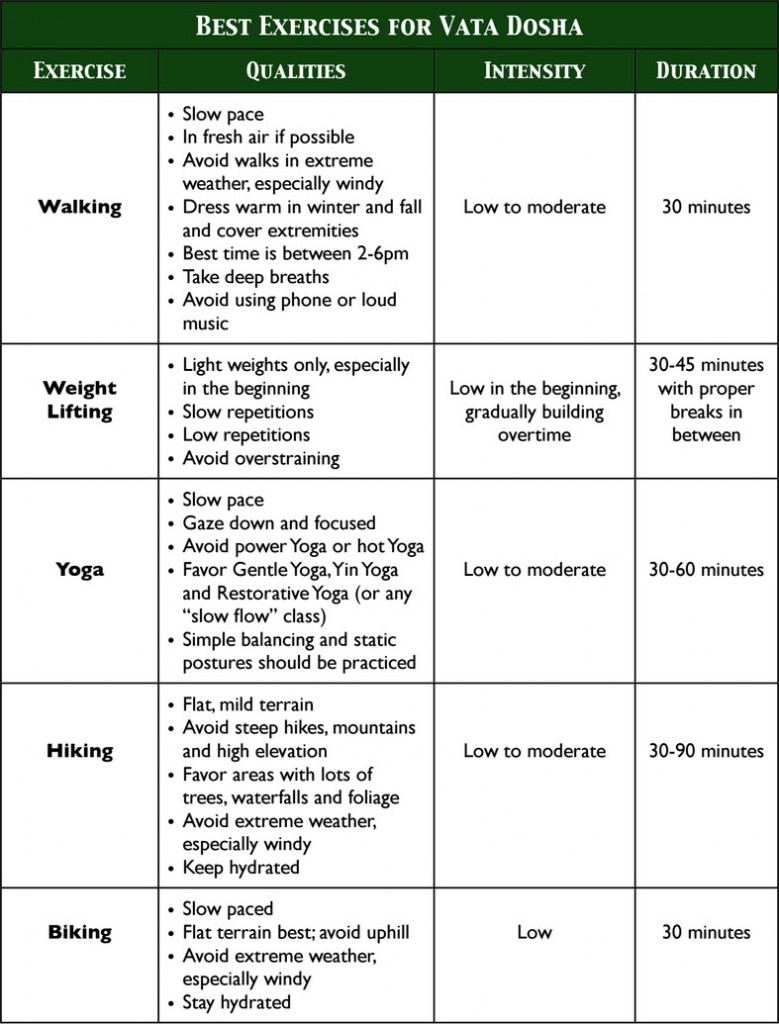
Best Exercises for Pitta Dosha
Pitta dosha is comprised mainly of the fire element (and secondary water) and tends to be hot and sharp by nature. Pitta types are often extremists and therefore should avoid overdoing it when it comes to exercise. The best exercises for Pitta types are medium in intensity and will avoid overheating the body and mind. This means that exercising outdoors in direct sunlight should always be avoided, especially at midday when both the sun and the Pitta are at their strongest point.
- Best time for exercise: Early morning or evening; avoid intense exercise at night as it can be too stimulating
- Favor: Medium pace, moderate intensity, cool environments, shaded areas
- Avoid: Direct sunlight, exercising mid-day (especially in summer), exercising in extreme heat, rigid regimens, and competitive exercise
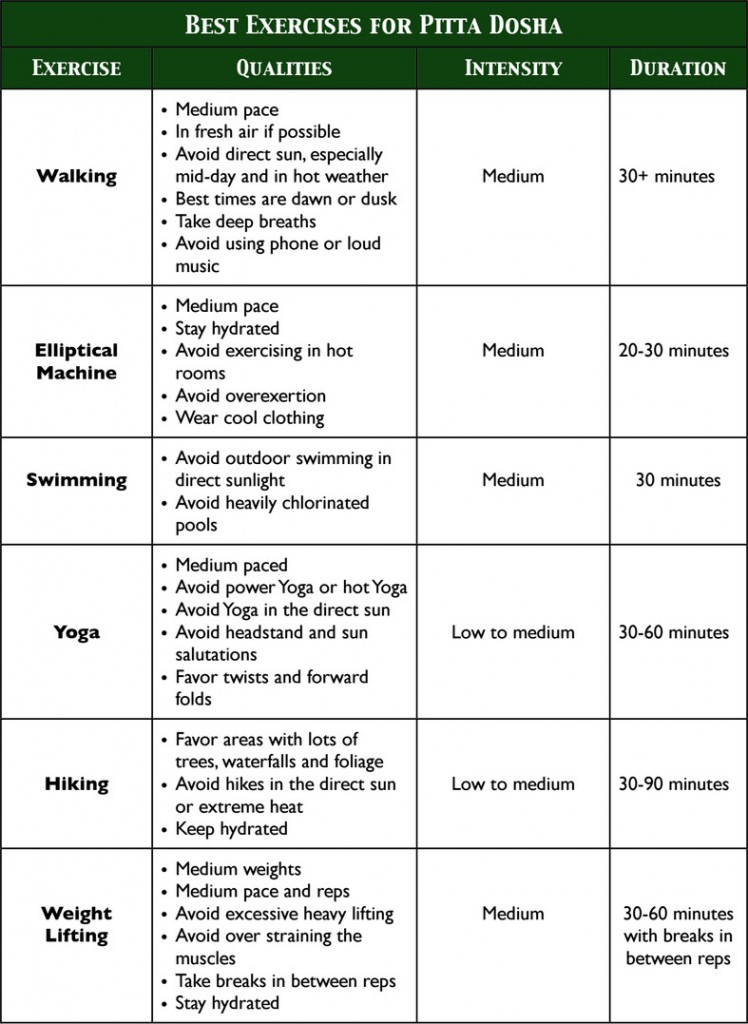
Best exercises for Kapha Dosha
Kapha dosha being predominant in both the Water and Earth elements manifests as slow, steady, and solid. Kapha types have strong constitutions, although if imbalanced they have a tendency to become sluggish, stagnant, and unmotivated. Therefore the best Kapha exercises will involve a faster-paced regimen that will help to get the blood pumping and the body moving!
- Best time for exercise: Between 6-10 in the morning (best) or 6-9 in the evening; avoid late-night exercise if it causes sleep issues
- Favor: Medium to high-intensity exercise, high reps, fast pace, low impact, and a variety of exercises
- Avoid: Slow pace, long breaks, low intensity, monotonous regimen, and excessive water drinking
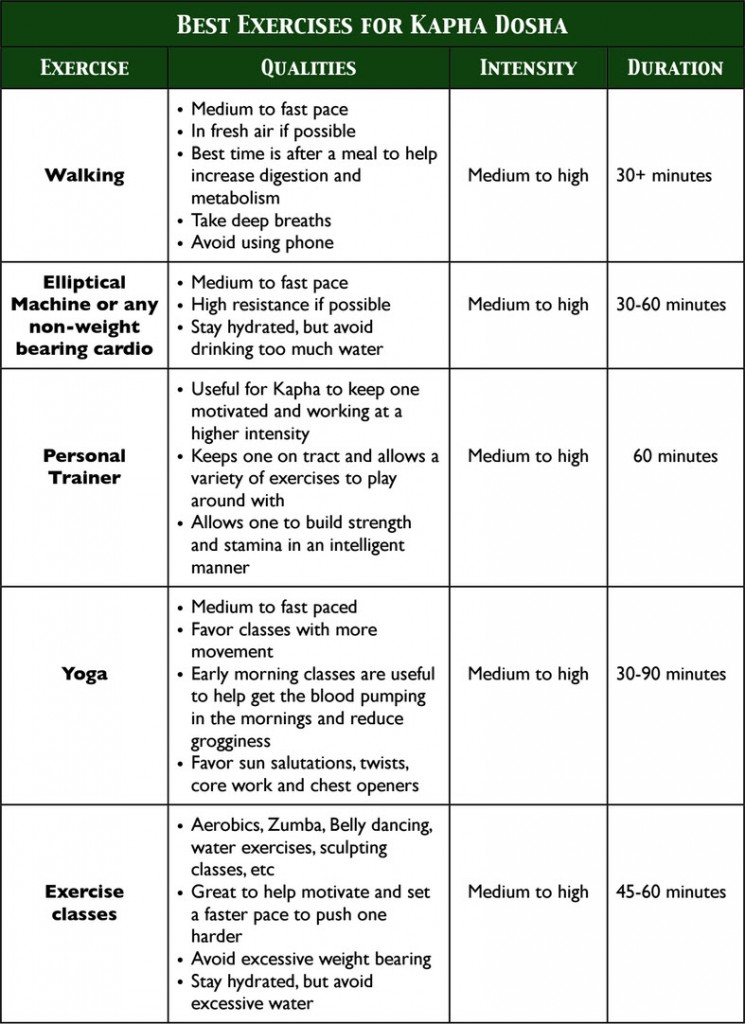
Conclusion
Just as with any substance or activity, exercise can bring you to a state of balance, or can create harm, depletion, and imbalance. Generally speaking, it is important to get at least 30 minutes of intentional movement (aka exercise) daily, but which type of exercises will be best for you will be determined by your age, level of strength, dosha type, current doshic imbalance, season, climate, and your overall personal needs. Getting too much or inappropriate exercise can lead to low Ojas, low Prana, high Vata, depletion, exhaustion, sleep disturbances, mental imbalance, and injury. Not getting enough exercise can lead to stagnation, lethargy, toxicity, slow metabolism, weight gain, high Kapha, mental fog, depression, and poor motivation. So take a moment to check in with yourself and determine the best exercises for your needs. Make a schedule that is realistic for you and make it happen. And most of all, make sure you are enjoying your new routine to really achieve long-term success!
Discover healing recipes with my 30-Minute Ayurvedic Cookbook!*
*By ordering directly through these links, you are helping to support Svastha Ayurveda – Thank you!!

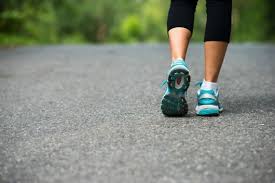
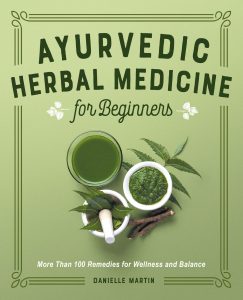
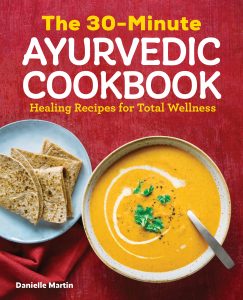

Hi, all this information about exercise, it’s great! thank you for sharing.
Could you explain why is the best time for exercise for vata 2-6pm? That is vata time, so doesn’t moving at that time increase the vata even more?
I have vata constitution and I do yoga in the morning. I am looking for the best time to walk long holes, so 2-6pm would be great, butjust curious about why it is the best time TIA
Hi Marelva,
This is a very great question! You are correct that excessive movement during the Vata time will provoke Vata even greater. However, the Vata-specific exercises listed are beneficial for Vata and therefore should help to pacify Vata during its “high” times of the day. For example, taking a gentle walk or hike in the fresh air will help to calm a restless mind, reduce anxiety, reduce stress, and promote overall peace and balance.
So with this being said, I would definitely say to add in your walk between 2 and 6pm each day. Just make sure it is at a mild pace, on flat terrain, and not too exerting. Of course you will want to avoid extreme weather conditions and stay well hydrated.
Thank you for this great question! Many blessings to you:)
Namaste,
Danielle
I eagerly anticipate each new post you publish, knowing it will be an enlightening journey. Your unique perspective and ability to make complex topics accessible are truly impressive.
Thank you for being a guiding light in the world of information, and for the genuine care you show towards your readers. Your blog has made a positive difference in my life, and I am sincerely grateful for that.
Hi Vedic Karma,
Thank you for writing in with these kind words! It means so much to me to hear. Feel free to write in with any questions if they come up. I am always happy to help!
Many blessings,
Danielle
Can kapha do weight training?
Hi Shawnda,
Thank you for your question! Kapha can do some weight training, but overall they do best with higher paced (but low impact) cardio exercise. Body weight exercise routines (performed without too long of breaks) and HITT type programs are great ways for Kapha to burn calories but still promote lean muscle.
Let me know if you have any further questions!
Be well:)
Namaste,
Danielle
Thank you for another helpful and well-communicated article reflecting your deep wisdom and understanding of Ayurveda and Yoga. I recently discovered your beautiful website and look forward to ordering your two books.
Hi Margaret,
Thank you for taking the time to write in! I am so glad you are enjoying the site. Feel free to reach out anytime if questions come up!
Until then, take it slow and be well:)
Namaste,
Danielle